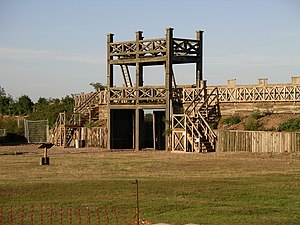Lunt Roman Fort
| Lunt Roman Fort | |
|---|---|
| Baginton, Warwickshire | |

The reconstructed main gatehouse as seen from inside the fort.
|
|
| Site information | |
| Open to the public |
Yes |
| Condition | Partially reconstructed |
The Lunt Roman Fort is the archaeological site of a Roman fort, of unknown name, in the Roman province of Britannia. It is open to the public and located in the village of Baginton outside Coventry, Warwickshire. The fort has now been fully excavated and partially reconstructed; the wooden gateway was rebuilt by the Royal Engineers using the same tools and techniques that the military engineers of the Roman Army would have used.
Nothing is known of the fort from the historical record; the site was discovered when large quantities of Roman pottery were found in the 1930s. Archaeological excavation started during the 1960s has revealed an intriguing site with three distinct periods of occupation namely a sequence of Roman military camps on the site.
The camp was occupied first by a legion, then, in the second phase by a cohort which reduced the size of the fort and demolished a number of buildings to construct a gyrus. This second phase lasted around twenty years until the fort was decommissioned. Over a century later it was recommissioned as a temporary fortification.
There is a large steep bank just beyond the northern boundary of the fort, which descends to the River Sowe. From the fort at the top of the bank there are good views of the landscape north for two or three miles (4.0 km) and buildings of Coventry city centre can be seen about four miles (6.4 km) away.
Lunt fort was an active site during periods of unrest in Roman Britain. The fort was built around AD 60 to act as a supply depot and headquarters for the Roman Army during the final campaign against Boudica.
The north, south and west sides followed the usual pattern for a Roman camp of straight ditches and ramparts. However, on the east side the defences bulge out and within the bulge a circular structure 32 m in diameter had been created. The sand and gravel subsoil had been dug out to a depth of 600 to 900 mm (24 to 35 in) and the area surrounded with a timber stockade.
...
Wikipedia
